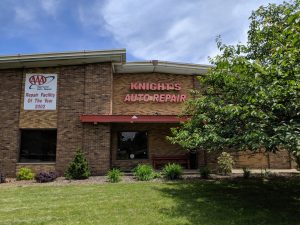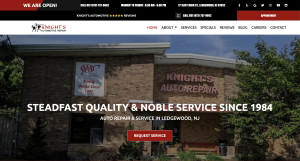Ensure you’re putting your business best foot forward online

Peyton Knight of Knight’s Automotive Repair
When was the last time you updated your website? When running a business, it can be easy to overlook the small details. One of the finer, but important, details is having up-to-date content on your website. Think of your website as a first impression for a potential customer. Does your business come off as engaging, helpful, and easy to use or is it hard to boring, confusing, and difficult to navigate? Would you go to a restaurant if you couldn’t find the menu or store hours? Then why would an automotive shop be any different.
Continue reading to learn the five metrics every automotive repair website should have to be successful! Marissa Ruiz, DRIVE’s Digital Marketing Manager, and Peyton Knight, owner of Knight’s Automotive Repair, share their tips for crafting an engaging website and how it can positively impact your business.
- Quality Content
The first thing you should prioritize is the content on your website. This is what sets the stage for your customers and what they should expect of your business. Are there grammatical errors or spelling mistakes? Small issues like that can deter someone from taking their car to you. Marissa says, “Whether you’re building a website from the ground up or seeking to enhance an existing one, for a website to be competitive, it’s important to have each section meet high standards. Potential customers should be able to know everything they need to about your shop.”

Marissa Ruiz of DRIVE
For example, your shop’s basic information must be easy to find. The hours of operation, the address, and the services you offer should be front and center. These simple elements should be on the home page. It can also be helpful to have a page dedicated to the “story” of your shop. This is where you can talk about how long you’ve been in business, how you’ve grown, and your plans for the future. You can also include photos and short biographies for your team.
Knight’s Automotive Repair has been open for 40 years and counting. Peyton can attribute a portion of his success and opportunities to his quality website. For instance, he says, “A reporter from Fox Business interviewed me about the high cost of auto parts. When I asked her why she chose my business, she mentioned once she saw my website she knew I was the perfect fit because of our shop’s culture.”
- Easy Navigation
Think about the last time you used a website, was it easy to get from page to page? Was it clear what information would be on each page? If it’s unclear and difficult to get to where you need to, you’re more likely to close out of that website and find another. Your tabs should be accurately labeled and have pertinent information. Marissa says, “If your website is difficult to use in any way, potential customers won’t pursue you. Someone clicking out of your website is money out of your pocket. It’s vital people can find effortlessly find out what they need to.”
So, make sure you’re not missing out on potential profits. Create a list of questions you would ask before going into an automotive shop then make sure each answer can be found on your website. The information should be placed on the correct page as well. For example, on Knight’s Automotive Repair’s website, there is a dedicated page for the specials they run. Having this in its’ own tab incentivizes customers to check it out and encourages them to go to Peyton’s shop for these deals.
- Clear Call to Actions

Knight’s Automotive Repair of Ledgewood, NJ
A website must tell users what to do once they’re on the page. Should a customer call your shop or is there a way to book an appointment online? By making it clear you increase the chances of a potential customer following through. On Knight’s Automotive Repair’s website, they have two call-to-actions on the website’s header. First, they have a “Call Us!” button that allows for someone to start dialing the shop’s number. Second, they have an “Appointment” button allowing someone to request an appointment time with them. It is clear that this is a request and that an employee will call to confirm the request once it’s submitted.
Peyton says, “Customers have consistently commented about how they find our website very appealing. Not only have I gained multiple new prospects from my website, but I’ve even gained employees! I have literally hired people as a result of my website.”
- Utilize Search Engine Optimization
Search Engine Optimization, or SEO, is the process of increasing website traffic by ensuring that the website appears at the top of search result pages. This can be done by editing your website’s content to reflect what your potential customers are searching for online. Marissa says, “It’s crucial that your content is optimized for search engines. Consider what potential customers might search for on Google when looking for your shop or your shop’s services, such as your city name and oil change.” So, make sure every service you offer is listed somewhere on your website.
Peyton uses DRIVE to manage his SEO output. He says, “Sales and revenue have increased substantially once I began using the technology DRIVE suggested to improve the business.”
Another option to increase website traffic is writing blog posts. These don’t have to be long or complicated, they can be as short as two paragraphs. If there are certain services you notice are more popular during specific times of the year, post a short piece about them. All you have to do is describe the service, mention how not handling it can negatively impact a vehicle, and finish it with a call to action to reach out to your shop!
- Professional Development

Knight’s Automotive website home page
Now, this might seem overwhelming if you have put updating your website on the back burner. But it’s important to consider your website as an ongoing marketing investment that will represent and support your business. Start small with one tip on this list and tackle another aspect the following week. If this seems out of your depth, you can always turn to a professional. That’s what Peyton did! He says, “DRIVE provided my business with a revamped website that has continually resulted in new customers and consistent compliments. They help me take advantage of SEO technology, customer reviews, shop photos, personal stories, biographies, and a section with automotive repair advice. The entire website is unique to our shop! We have been able to showcase our achievements, interviews, and videos from family and customers.”
Marissa states it clearly, “While hiring professionals may seem like a higher upfront cost, when it’s managed by professionals it often saves money in the long run. A well-built website requires fewer fixes, avoids costly downtime, and is scalable as your business evolves.”
Whether you’re updating your website yourself or putting it in the trusted hands of professionals, be certain to include these five tips! You’ll see a rise in customer acquisition, sales, and revenue. Remember, your website is often your shop’s first impression. Make sure it’s a good one.
# # #
By Chase Clough







 For DRIVE clients, click
For DRIVE clients, click 
